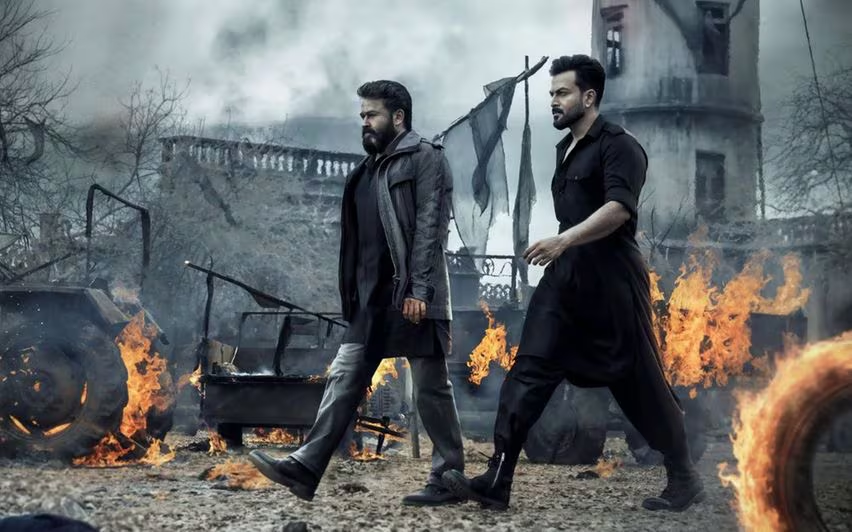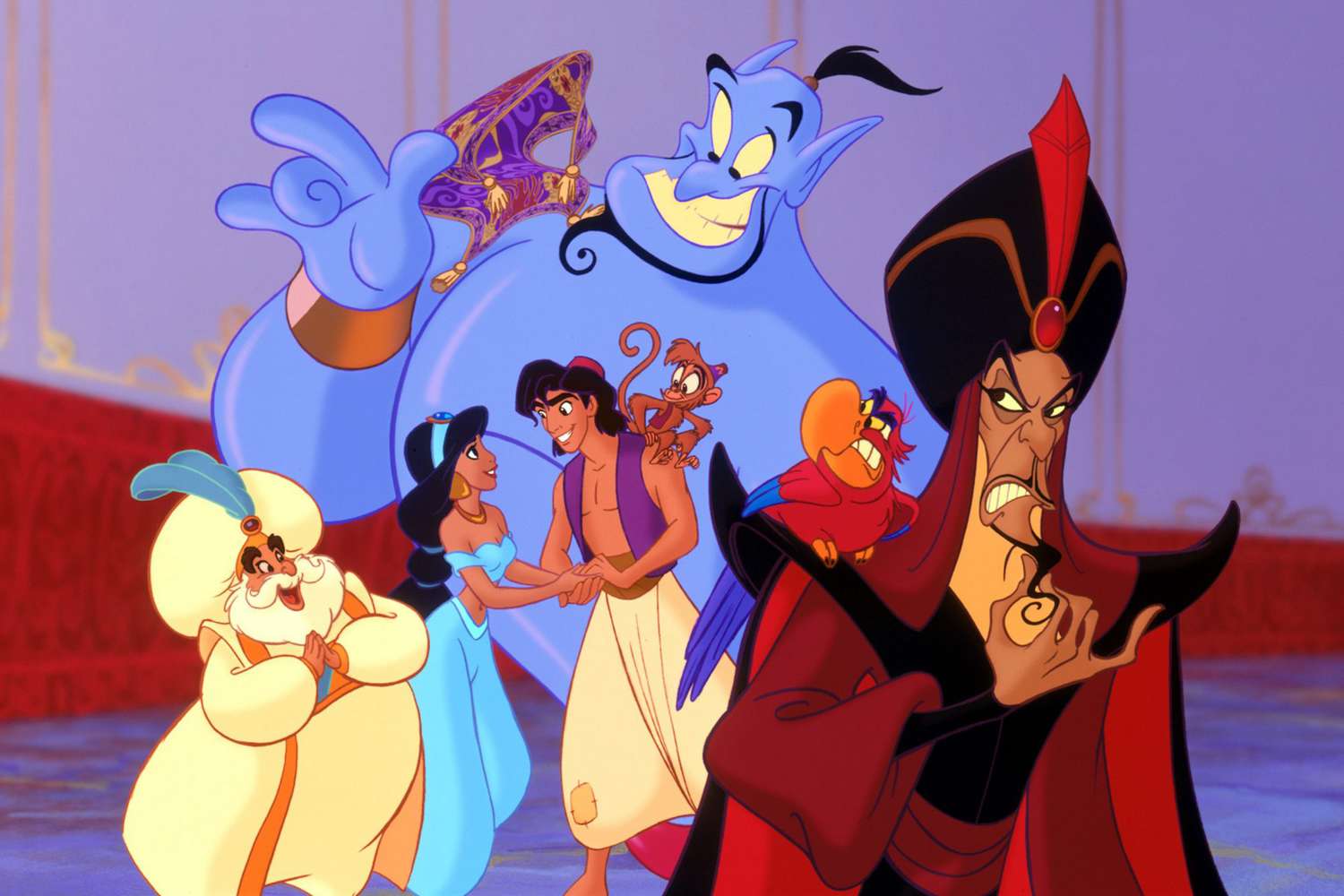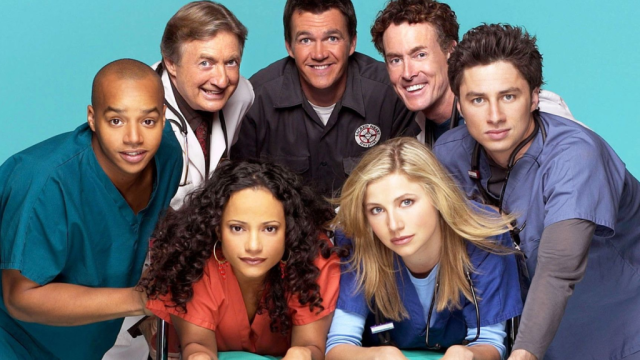

TV
Everything we know about the Scrubs Reboot
After months of speculation, with fans salivating over dropped hints on social media; we have it confirmed! The Scrubs reunion is definitely happening! Scrubs creator Bill Lawrence has been quoted as saying: “We’re gonna do it because people still care about it and we enjoy spending time with each other” (Independent.co.uk, 2024).
Scrubs was a sitcom staple that ran from 2001 until 2010. Eight seasons with the original cast followed by a somewhat ill-fated ninth season with a mix of original and new characters. Starring Zach Braff as John Dorian ‘JD’, a daydreaming young doctor and king of the non-sequitur due to his various bizarre fantasies. The series follows JD as he progresses from an intern to an accomplished resident under the tutelage and biting sarcasm of his reluctant mentor, senior doctor, and fan favorite; Dr Cox (played by John C McGinley). JD’s friendships, romances, and multiple embarrassments have been immortalized through reruns and thousands of diehard fans.
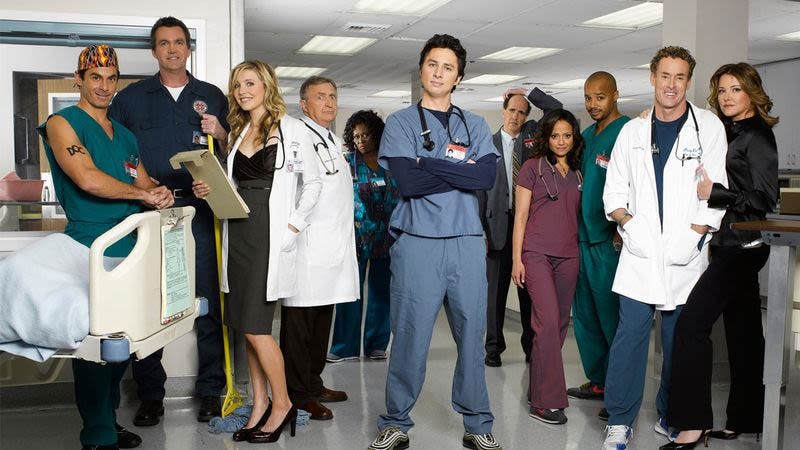
In recent years entertainment has been enriched with various reboots and reunions from 90’s – early 00’s TV shows (Friends, Sex and the City, and Frasier to name but a few). Fans have been teased with the possibility of a Scrubs reboot for years by the cast themselves.
In July 2023, Christa Miller who not only played series regular ‘Jordan’, is also married to Bill Lawrence, posted a picture on her Instagram. The picture includes Braff, McGinley, and Lawrence, Miller quips about a Scrubs reboot. Both Miller and McGinley simultaneously posted the same picture in April ‘24, when the majority of the cast met up for a ‘pizza party’. McGinley posted the photo on X (formerly Twitter) including his comment “…getting the band back together”.
McGinley has since confirmed exclusively to Thatsmye.com, not only that there will be a reboot but also his involvement:
“…we all were in agreement that: as long as Billy (Lawrence) is at the helm of this reboot? We would all dive-in, with reckless abandon!”
This proclamation will surely send fans into a frenzy speculating just what a Scrubs reboot will look like.
Braff himself was asked during an interview with Screen Rant what he thought JD would be up to these days. Braff reminds the audience that JD is a “grown a** man now” (according to the show’s timelines JD would now be 50) and would probably be more in the Dr Cox position. Braff has an interesting pitch of present JD yearning to return to the “innocence of his youth”(Screen Rant, 2024). Over thirty years in medicine would wear anyone’s positivity down. Braff would like to see a jaded JD trying to recapture some of the joy from his youth.

And what of JD’s snarky mentor? Dr Cox would now be 65, the average age US physicians retire. Would a character as committed to his job as Dr Cox be able to retire completely? It would be ironic if Dr Cox, after getting some distance from modern health care, becomes the positive one of the dynamic. Would Dr Cox return the favor of years previous and help JD find joy in helping people again? However, would this be staying true to the misanthropic, ranting attending that the fandom fell in love with?
Fans have also discussed the possibility of a reboot including the character’s canonical children in the original series run. Dr Cox’s and Jordan’s son, Jack, would now be 21. JD’s own son, Sammy, would be 17. Izzie, the daughter of JD’s best friend Turk (played by Donald Faison) and his wife Carla (played by Judy Reyes) would be 18. Will this new generation play a big part in the reboot? Some fans suggested Jack would be following his father’s dream of being an ice hockey player and that Izzie would be following in her parent’s footsteps into medicine.
It’s all fun to speculate what the Scrubs gang would be doing with the backdrop of 2024/25. However, it cannot be denied that the cultural landscape has changed since the 00s. Shows such as Friends and Sex and the City have met a reckoning of sorts for their lack of diversity and their portrayal of certain minority groups. Past sitcoms look very different under the lens of the ‘20s, particularly after the historic events of recent years.
Scrubs has faced its own share of criticism over its comedic use of blackface. In the context of the show, the use of blackface is when JD is imagining himself or other cast members as his African American best friend Turk. Scrubs episodes are punctuated by JD’s outlandish daydreams. In the wake of the BLM protests over the summer of 2020, Braff and Faison used an entire episode of their Scrubs rewatch podcast ‘Fake Doctors, Real Friends’ (available on Spotify) to discuss the use of blackface in the TV series.
The podcast episode is titled; ‘Our Difficult Past: Blackface on Scrubs’ was originally aired on June 29th 2020 and ran for around 42 minutes. The episode included Bill Lawrence and actress Sarah Chalke, who played ‘Elliot’. Three episodes of the TV show included blackface ‘gags’.
Lawrence takes full responsibility for the content, although all four members took accountability and offered their sincere apologies. Lawrence didn’t want to make excuses but elucidated the reasoning of his past self. The showrunner blamed it on “the arrogance that comes with success” (Braff, 2020). He thought they had a “free pass” as they had created such a diverse show both in front of and behind the cameras. For the era, Scrubs was extremely progressive, with a diverse main cast, an interracial couple starring in the show, and a varied age range among the stars.
The episodes in question were immediately pulled from Disney+ under Lawrence’s instruction. At the time of this publication, the episodes are still removed from Hulu, and two of the three are from Amazon and iTunes. Lawrence has also received criticism from the other side of the cultural divide; that the situation is another example of PC culture ruining art. However, Lawrence is steadfast in his belief that art is better for it. When doors are opened for people of different backgrounds and experiences to tell their stories, it can only enrich and diversify storytelling.
Being accepting of one’s own mistakes makes us more understanding and compassionate which ultimately makes us better storytellers. Lawrence and the rest of the cast will take these experiences and lessons when creating what is sure to be a fantastic reboot. Unlike other reboots such as ‘Sex and the City’ which tried to course-correct after the criticisms that the original series wasn’t diverse enough in its casting. The reboot seems to overcompensate by quickly adding a plethora of new characters who are POC, disabled, and non-binary. Even with the best intentions, this comes across as tokenism. Scrubs already had a diverse cast for a mainstream show.

Lawrence told Joe.co.uk that we can expect a reboot in “six months to a year” (Joe.co.uk, 2024). Whatever a reboot will look like, fans will eagerly await it and speculate just what a ‘20s Scrubs will include. With Lawrence’s passion, Braff’s unique insight, and McGinley’s enthusiasm it will sure to be an exciting addition to a classic show.
TV
With the tragic news of Michelle Trachtenberg’s death, we at That’s My Entertainment wanted to pay tribute.
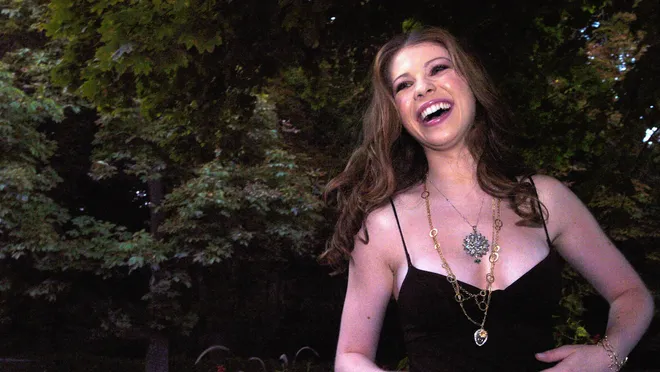
With her ice-blue doe eyes, enviable long, shiny brown hair, and button nose; Michelle Christine Trachtenberg looked every bit the prolific child star she was. Often described as radiating the type of vulnerability that Hollywood just loves in its young stars.
Trachtenberg acted in commercials from the age of 3. At the age of 10 she starred in Harriet the Spy (1996) as the titular spy. However, most of her fans will forever know her as Dawn Summers the (sometimes bratty) kid sister of Buffy Summers star of the cult TV show; Buffy the Vampire Slayer (1997-2003). Trachtenberg joined the main cast for the shows fifth season in 2000.
Dawn’s introduction heralded the dawning of a newer, more adult era of what was still seen as a teen supernatural drama. Trachtenberg’s character and introduction is still somewhat controversial in the Buffy fandom. Though loathed by some, no one could deny Trachtenberg’s obvious talent and how well she fit in with the main cast. Trachtenberg had worked with the show’s star, Sarah Michelle Gellar, in the long-running show All My Children (1970-2013), Gellar even recommended Trachtenberg for the part of Dawn. Buffy’s producers loved Trachtenberg despite the fact that Dawn’s character was initially written as a younger one. This is why a lot of Dawn’s dialogue and actions initially seem like that of a much younger child. This served to annoy certain fans even more.
Despite the ire, Buffy and Dawn’s sibling, and, oftentimes, paternal relationship became a touchstone of the 7-year-long series. Viewers watched Dawn develop from an immature girl to a capable young woman who calls others (particularly men) out on their bullshit. Many women identified with Dawn’s journey of attaining her autonomy. Even the biggest Dawn critics can’t argue that Dawn was a pivotal character in many of Buffy’s groundbreaking episodes, such as (spoilers!); The Body where the sister’s mother dies to Buffy’s resurrection in Bargaining. Dawn processed loss and dysfunction at a very young age. An inside joke in the Buffy fandom is that you know you have matured when you become a Dawn sympathiser.
After Buffy Trachtenberg took on maturer roles such as Jenny in the 2004 teen sex comedy EuroTrip. The trailer of which included a deleted scene with Trachtenberg’s character flashing her bra at passing cars whilst hitchhiking. Scenes such as these pivot greatly from the innocent Dawn Summers.
Trachtenberg would continue to work regularly, guest starring in TV shows such as Six Feet Under (2004) and House (2006). In 2008 Trachtenberg took on the role of manipulative socialite Georgina Sparks in Gossip Girl (2007-2012). Her Gossip Girl co-star; Blake Lively, described Trachtenberg on an Instagram post as; “…electricity. You knew when she entered a room because the vibration changed”. Trachtenberg was certainly energetic in interviews and threw herself into every acting challenge with aplomb.
Growing up in front of the camera meant that Trachtenberg fell victim to the objectification of her changing body. At the time it was unfortunately common for certain sites to be devoted to counting down the days until a certain starlet turned 18. In response to her own ‘Trachtenberg to 18’ counters: “You’re never gonna get a chance! So what’s your counter for?”
Cut to 2021, fellow Buffy castmate Charisma Carpenter opens up about the cruel treatment she received working under Buffy and its spinoff Angel (1999-2004) creator Joss Whedon. Carpenter bravely spoke of the misogyny, sexual harassment, and bullying she endured from Whedon that still affects her to this day. Carpenter’s claims became the pin that finally deflated Whedon’s godlike presence in the entertainment industry.
Trachtenberg stood with Carpenter; posting on her own social media that as a now 35 year old being “brave enough” to share her story about Whedon. She agreed with Carpenter saying: “This must. Be Known. As a teenager. With his not appropriate behaviour…very. Not. Appropriate.” She would later add to this statement by saying there was a rule on-set that Whedon was not allowed alone in a room with her again. Trachtenberg would have been around 15 working on Buffy.
Michelle Trachtenberg feeling strong enough to stand up to an alleged abuser such as Whedon and others like him mirrors not only Dawn’s growth but the overarching arc of Buffy the Vampire Slayer. The dark irony of Whedon’s alleged true nature as he created some of the greatest feminist icons is not lost. However, with Trachtenberg, Carpenter, Gellar, and many other actresses standing up for themselves and each other is really what the fictional show was about.
Trachtenberg was a great actress but she was also instrumental in helping to dismantle the sexist power dynamics within the industry for future generations of performers.
Much like her character Dawn, Trachtenberg found her voice and her strength in the face of insidious forces. As tragic as her untimely death is, she will always be remembered not just for her talent but for her bravery in facing years of oppression and objectification. Rest In Power Michelle Trachtenberg, you are truly a feminist icon both on and off of screen.
TV
CBS’s new show Watson breathes new life into the beloved Sherlock Holmes universe,

CBS’s new show Watson breathes new life into the beloved Sherlock Holmes universe, offering a modern adaptation that both honors its roots and explores fresh, contemporary themes. As a long-time fan of Sherlock Holmes, I was eager to see how this reimagining would unfold, and I am thrilled to say that Watson delivers a compelling and dynamic take on the classic characters.
Morris Chestnut’s remarkable portrayal of Dr. John Watson is at the heart of the series. Traditionally seen as the steadfast companion to Sherlock Holmes, Watson takes center stage in this adaptation, and Chestnut’s performance is nothing short of outstanding. Transforming Watson into a leading figure whose personal journey is as captivating as the mysteries he helps solve. Chestnut’s Watson is a character in his own right, not merely a sidekick, and his modern sensibilities breathe fresh air into the role.
The show’s setting in contemporary times is executed with finesse. By weaving modern-day elements into the narrative, Watson manages to stay true to the essence of Sir Arthur Conan Doyle’s original stories while making them accessible and relevant to today’s audience. The dynamic between Watson and the world around him is engaging and entertaining, offering new perspectives on themes such as justice, loyalty, and intellect. Fans of the original tales will appreciate the clever nods to classic storylines, while newcomers will find plenty to enjoy in the updated context.
Spoiler alert:
One of the most striking elements of the show is Randall Park’s portrayal of James Moriarty. Traditionally envisioned as a calculating and sinister adversary, this version of Moriarty offers a fascinating twist. Park’s performance combines darkness with a sharp, comedic edge, creating a character who is as unpredictable as he is engaging. This fresh take on Moriarty elevates him beyond a mere antagonist, making him a multidimensional figure who should keep viewers guessing at every turn.
Overall, “Watson” is a bold and refreshing addition to the Sherlock Holmes universe. Featuring compelling performances, clever integration of modern elements, and innovative character dynamics, the show provides something new and exciting for both longtime fans and newcomers to the world of Holmes and Watson. It’s a must-watch for anyone seeking a smart, entertaining, and thoroughly engaging adaptation of these timeless characters.
TV
Did JD from Scrubs Have a Dark Past?
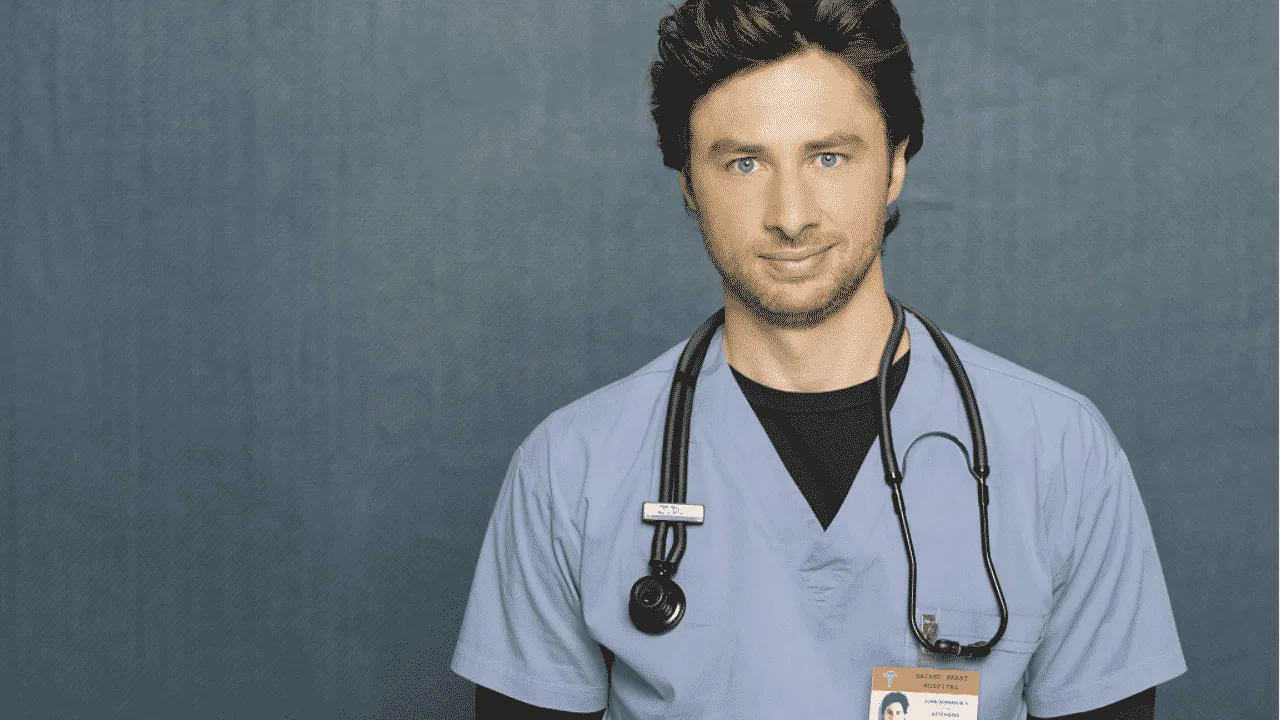
TW: Discussions of child abuse and neglect.
The sitcom Scrubs ran from 2001- 2010 delighting viewers with the escapades of daydreaming Dr ‘JD’ Dorian and his friends. Unlike most TV sitcoms Scrubs perfectly balanced the comedic and the tragic. Being set in a teaching hospital with most of the main cast being doctors; there was plenty of fodder for some truly heart-wrenching storylines.
Like with most sitcoms, if you look under the jolly veneer (and have too much time on your hands) a much darker story emerges. In Scrubs, I would argue, this may be the past of its titular protagonist JD (played by Zach Braff). Some fans (ok, me) speculate that not only did JD have a less than ideal childhood but an abusive one.
Hints of this could be interpretated throughout the series:-

1. Attachment to Dr Cox
One of the most popular aspects of the series is the oddly touching relationship between mentor and mentee: Dr Cox (John C McGinley) and JD. It’s perfectly normal to admire and want to emulate an older colleague. But JD’s admiration of Dr Cox always seemed to go a step further. JD looked to the older doc as not only a mentor but a father figure.
JD explicitly states this throughout the series. Most notably in the finale; when during his much sought after hug JD claims Dr Cox smells “like a father figure”. This is odd as Dr Cox is only about 13 years JD’s senior. We know JD’s biological father (played by the late John Ritter) was pretty much absent during JD’s childhood. Is this yearning for a parental figure a way to fix JD’s damaged childhood?
As loathe as I am to criticise a fan favourite but Dr Cox openly mocks and belittles JD, almost never referring to his protégé by name. Instead by a vast archive of disparaging nicknames. The show does establish that there is love and respect om both sides, from Dr Cox deep down (deep, deep down). But why does JD not only put up with as well as seek out this treatment? Very masochistic. Or, has JD been subconsciously taught that taunts and aggression equate to love?
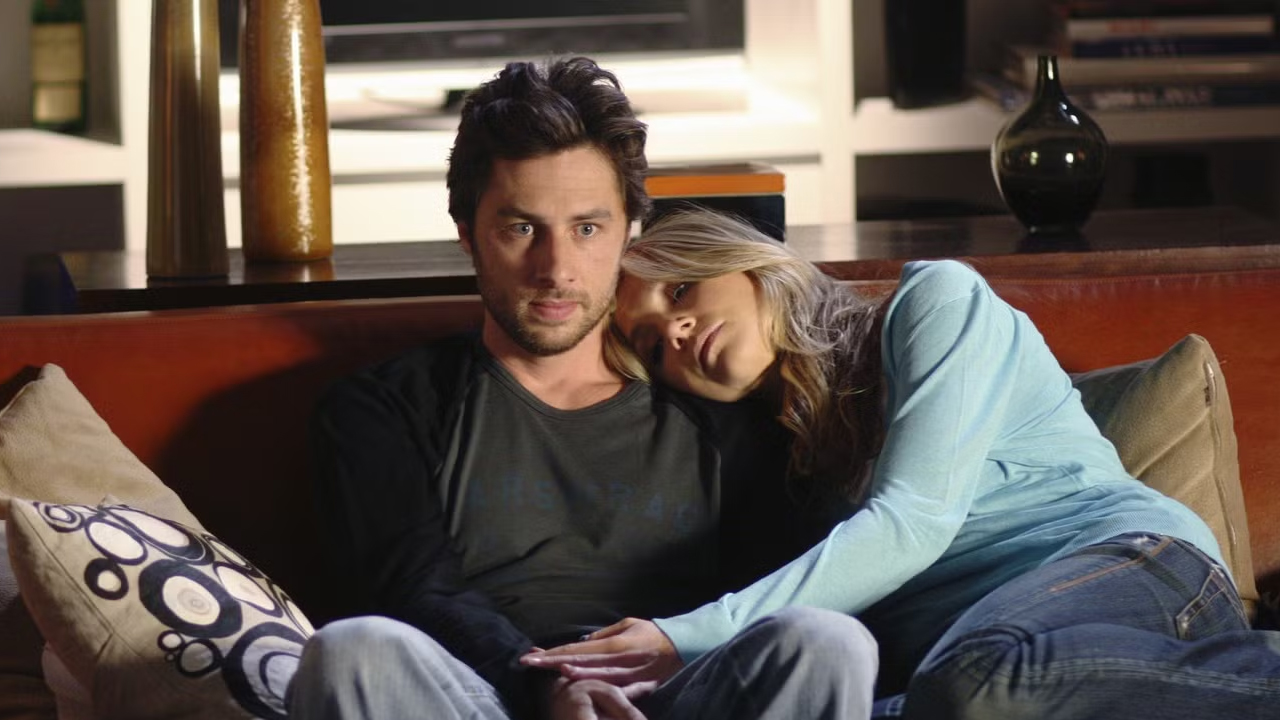
2. Feels Affinity with Dr Cox and Elliot
The show establishes early on that Dr Cox had an abusive homelife as a child. He openly reminisces about his parents being violent alcoholics. Is this the real reason that JD clamours for Dr Cox’s attention? Does JD see Dr Cox as an inspiration of someone who came from a similar background to his and became a well-respected doctor and family man?
Is the same true of JD’s on/off girlfriend, future wife and fellow doctor; Elliot? The show establishes that Elliot’s parents are mentally, emotionally, and financially abusive. Are JD and Elliot drawn to one another (partly) because they are both traumatised by their past? Even when it is proven time and time again that they are not suited.

3. Hostile Relationship with Older Brother
JD’s older brother Dan (Tom Cavanagh) appears several times in the show. Despite regularly visiting his kid brother, JD makes clear that these visits are not welcomed. JD’s ire is uncharacteristic as he’s shown as an ardent people pleaser throughout the show. Yes, Dan did bully JD throughout their childhood, though it’s unclear whether this was normal sibling rivalry or more.
In Series 3 Episode 5 ‘My Brother, Where Art Thou?’ JD attempts to cut off contact with Dan claiming that Dan never looked out for him. Even as children of divorce why is JD so upset his brother didn’t protect or “come through” for him? In the same scene JD comments about how their mother “married anyone that rang the doorbell”. Reading into this (hey, it’s what we’re here for) did Dan not protect JD from these multiple husbands?

4. Audience Never Actually See JD’s Mother
To me this is the most obvious that something is suspicious about the Dorian matriarch. Despite seeing every other cast members mother (except Dr Cox but its implied that his parents are dead) we never see JD’s. He, at the very least, seems to have a good relationship with his mother. Mostly speaks highly of her and she calls often. It doesn’t follow the trope many sitcoms use; having a character the audience never physically sees being used for comedic effect.
We hear JD’s mum (Barbara) speak in a flashback (Series 3 Episode 21 ‘My Self-Examination’). While Barbara was tucking young JD into bed she was saying some quite toxic things to her child, like how no women will ever be good enough for him. It is clear this scene is supposed to be somewhat creepy as Barbara is stroking the child’s face in an inappropriate manner. Adult JD even refers to his mum as “sexy” in the same episode. Very Freudian but in the light of everything else we are discussing: very disturbing!
5. JD’s Mother Drank
Linked to number 4 JD admits in Series 8 Episode 2 ‘My Last Words’ JD admits his mum “drank a lot”. Does this statement answer some questions about JD’s odd childhood?
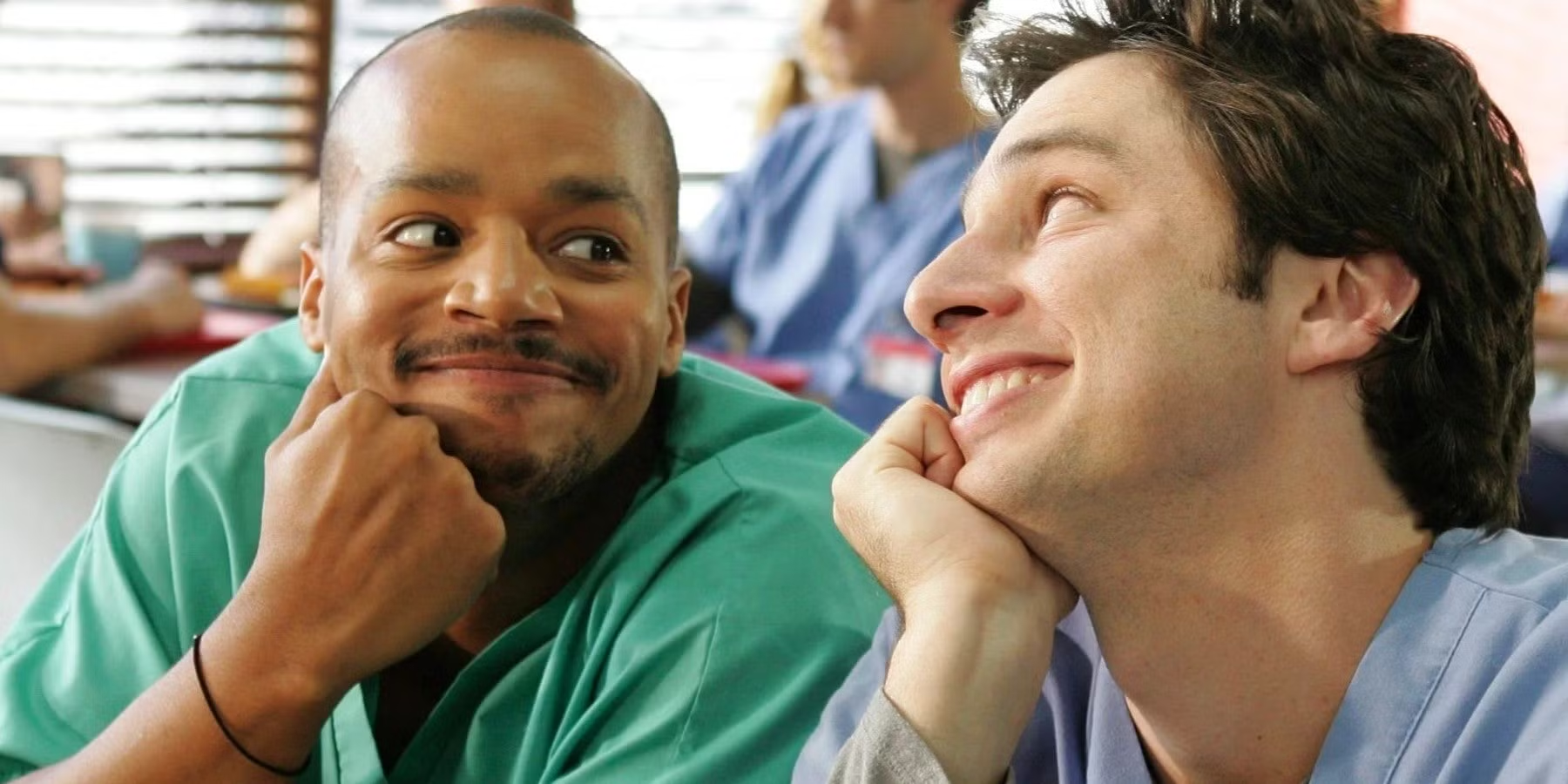
6. JD is a People Pleaser
As we have already mentioned JD is a pathological people pleaser (what’s that like?). As a doctor he goes above and beyond for his patients. He does everything from finding patients estranged family members (Series 4 Episode 11 ‘My Unicorn’) to shaving his head in solidarity with a chemo patient (Series 5 Episode 15 ‘My Extra Mile’). Of course this is all very commendable but JD particularly enjoys the gratitude. Why does he need this validation? Is this a coping mechanism from a turbulent background who had to go above and beyond to get the love that should have been unconditional?
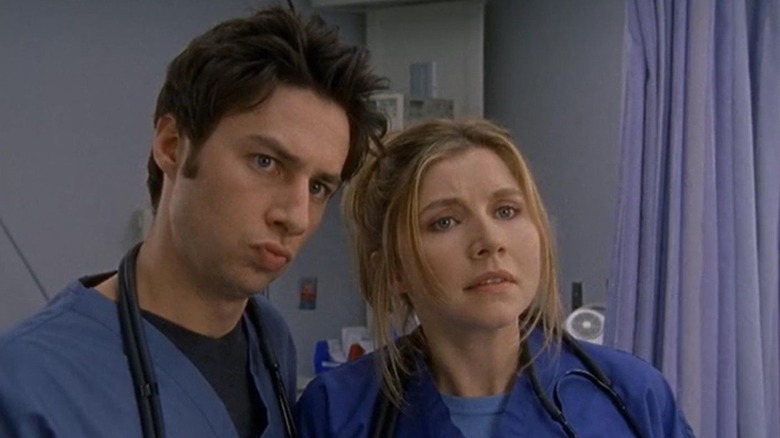
7. Extremely Tactile
Another of JD’s character traits is he extremely tactile. This is of course played up for comedy with his ‘sneak hugs’ (Series 6 Episode 13 ‘My Scrubs’) delivered to the stand-offish Dr Cox or the fact he has his friends on a ‘hugging schedule’ (Series 5 Episode 8 ‘My Big Bird’). Is this someone trying to seek the love and affection he never received in childhood? Or reassure himself that the people he loves won’t disappear?

8. Self-Sabotaging
A common reaction to childhood trauma is self-sabotaging behaviour. In his romantic relationships JD has this in spades. Throughout the run of the show JD has more romantic partners than the rest of cast put together. It is acknowledged that JD goes from relationship to relationship with alarming speed and breaks them off for shallow reasons. Again, he may be trying to seek the love and security he never had in childhood.
JD’s damaged psyche is put on full display when after spending the majority of the series chasing Elliot she finally leaves her loving boyfriend for him. JD immediately decides he doesn’t want her anymore to many fans outrage (Series 3 Episode 20 ‘My Fault’).

9. No Therapy
As well as never actually seeing his mother, we never see JD engaged in any kind of therapy. All of the other characters attend various types of therapy throughout the series. JD does not, despite arguably needing it the most. Is JD perhaps too scared of what therapy might uncover or not want to deal with his trauma head on?

10. Overactive Imagination
During Scrubs entire run (except the final series thou shalt not be named) hinges on JD’s overactive imagination. His outlandish fantasies make for excellent comedy and unique sequiturs to break up the storylines. But what if this was yet another coping mechanism for the hapless leading man?
Children from challenging background often disappear into elaborate fantasy worlds in order to escape their surroundings. Is this a habit JD could never quite kick? It would explain why he doesn’t seem to have a lot of control of his daydreaming despite being an adult. It is a comfort and a way to deal with the difficult stuff life throws at him.
If any or all of these speculations are true Scrubs goes from being a mere half-hour sitcom to a story of one man’s triumph over his dark past. Despite his flaws and failings JD has still made something of himself and is surrounded by his chosen family; all of whom love him for who he is. This is extremely inspiring.




